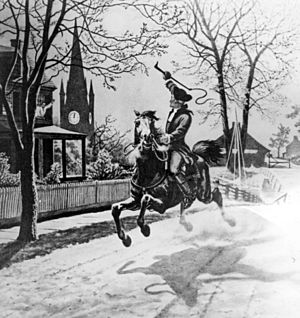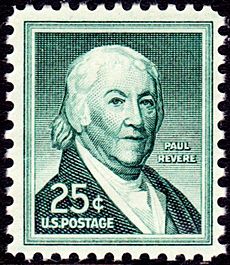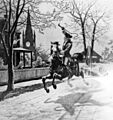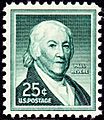Paul Revere's Midnight Ride facts for kids
The Midnight Ride was a super important event in April 1775. It was a secret alert given to American colonists before the first big fights of the American Revolutionary War. This warning helped the colonists get ready for the British soldiers who were coming.
The ride happened on the night of April 18, 1775, right before the battles of Lexington and Concord. These battles were the very start of the American Revolutionary War. Weeks before, the British Army seemed to be planning something big against the Massachusetts Provincial Congress, which was like the colonists' government, based in Concord.
Paul Revere and William Dawes were chosen to give the warning. The signal started when Robert Newman, who worked at Boston's Old North Church, used lanterns to tell colonists in Charlestown that the British Army was moving by crossing the Charles River. After seeing the signal, Revere and Dawes rode to meet important leaders like John Hancock and Samuel Adams in Lexington. They also warned about 40 other riders along their way.
Revere and Dawes then headed towards Concord with Samuel Prescott. But the three were stopped and captured by British troops in Lincoln. Prescott and Dawes managed to escape, but Revere was taken back to Lexington. He was questioned and then set free. By giving the colonists an early warning, the ride played a huge part in the colonists winning the battles that followed.
This famous ride has been remembered in many ways. The most well-known is Henry Wadsworth Longfellow's poem from 1861, "Paul Revere's Ride". This poem has really shaped how people remember the event today.
Contents
Why the Ride Happened
British Army actions on April 7, 1775, suggested that troops might be moving soon. Because of this, Joseph Warren sent Revere to warn the Massachusetts Provincial Congress. This group was meeting in Concord, where a lot of the colonists' military supplies were hidden. After getting the warning, people in Concord started moving their supplies to safer places.
A week later, on April 14, General Gage, the British commander, got orders from England. He was told to take away weapons from the colonists, who were called "rebels." These weapons were hidden in Concord and other places. He was also told to arrest the leaders of the rebellion, especially Samuel Adams and John Hancock. General Gage had a lot of freedom in how he carried out these orders. He told Lieutenant Colonel Francis Smith to go from Boston "very quickly and secretly" to Concord. There, Smith was to "seize and destroy" all military supplies. But Gage also said the soldiers should not steal from people or damage private property. Gage did not write down orders to arrest the rebel leaders because he was afraid it might cause a big uprising.
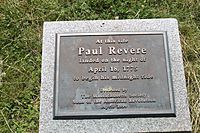
Between 9 and 10 p.m. on April 18, 1775, Joseph Warren told Revere and William Dawes that British soldiers were about to leave Boston by boat. They were heading towards Cambridge and then to Lexington and Concord. Warren's information suggested the British mainly wanted to capture Adams and Hancock. They weren't worried about Concord's supplies, as they had already been moved. But they thought the leaders in Lexington might not know about the danger. So, Revere and Dawes were sent to warn them and to alert the colonial militias in nearby towns.
The Ride's Journey
Getting Ready
Days before April 18, Revere had told Robert Newman, who worked at the Old North Church, to send a signal using lanterns. This signal would tell colonists in Charlestown how the British troops were moving. The famous signal was "one if by land, two if by sea." One lantern in the church steeple meant the army was going by land. Two lanterns meant they were going "by water" across the Charles River. The British ended up taking the water route, so two lanterns were placed in the steeple.
Revere first gave instructions for the signal to be sent to Charlestown. Then, he crossed the Charles River in a small rowboat. He quietly passed the British warship HMS Somerset which was anchored there. Crossing the river was not allowed at that time of night. But Revere safely landed in Charlestown and began his ride to Lexington. He avoided a British patrol and warned almost every house along his path. The colonists in Charlestown then sent out even more riders to the north.
The Ride Itself
As Revere rode through areas that are now Somerville, Medford, and Arlington, he warned patriots along his way. Many of these patriots then got on their own horses to spread the warning even further. By the end of the night, there were probably as many as 40 riders across Middlesex County carrying the news of the army's advance.
Revere did not shout the famous phrase "The British are coming!" His mission needed to be secret, and the countryside was full of British army patrols. Also, most colonists in Massachusetts still thought of themselves as British. According to people who saw the ride and Revere's own accounts, his warning was "The Regulars are coming out." This meant the professional British soldiers were on the move.
Revere arrived in Lexington around midnight. Dawes arrived about 30 minutes later. They met with Samuel Adams and John Hancock, who were staying with Hancock's relatives at what is now called the Hancock–Clarke House. They spent a lot of time talking about what to do after hearing the news. They believed the British forces leaving Boston were too large just to arrest two men. They thought Concord was the main target. The men in Lexington sent riders to nearby towns. Revere and Dawes then continued towards Concord with Samuel Prescott. Prescott was a doctor who happened to be in Lexington "returning from a friend's house at the awkward hour of 1 a.m."
The ride of these three men started a quick warning system that had been planned months before. This system was a better version of an old way to quickly tell people and gather local militia forces in emergencies. Colonists had used this system for a long time, even during early Indian wars. Besides other riders delivering messages, bells, drums, alarm guns, bonfires, and a trumpet were used to spread the word quickly from town to town. This told rebels in dozens of eastern Massachusetts villages to gather their militias because more than 500 British soldiers were leaving Boston with possible bad intentions. This system worked so well that people in towns 25 miles (40 km) from Boston knew about the army's movements while the soldiers were still getting off their boats in Cambridge. The alarm raised by the three riders helped the militia meet the British troops in Concord and then chase them all the way back to Boston.
Capture and Escape
Revere, Dawes, and Prescott were stopped by a British Army patrol in Lincoln. They were at a roadblock on the way to Concord. Prescott bravely jumped his horse over a wall and escaped into the woods. He eventually made it to Concord. Dawes also escaped, though he fell off his horse soon after and didn't finish his ride.
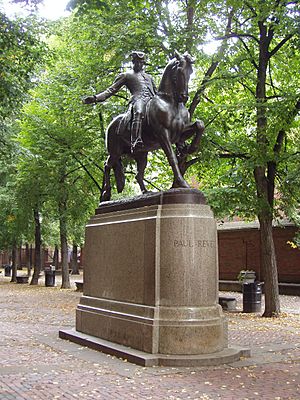
Revere was captured and questioned by the British soldiers who held guns to him. He told them about the army's movement from Boston. He also warned them that the British troops would be in danger if they went to Lexington because many angry militia members were gathered there. Revere and other people captured by the patrol were still taken east towards Lexington. About half a mile from Lexington, they heard a gunshot. The British major demanded Revere explain the gunfire. Revere replied it was a signal to "alarm the country." As the group got closer to Lexington, the town bell started ringing fast. One of the captives then told the British soldiers: "The bell's a'ringing! The town's alarmed, and you're all dead men!"
The British soldiers talked among themselves and decided not to go further towards Lexington. Instead, they freed the prisoners and headed back to warn their commanders. The British took Revere's horse and rode off to warn the approaching army. Revere walked to Rev. Jonas Clarke's house, where Hancock and Adams were staying. As the battle started on Lexington Green, Revere helped Hancock and his family escape from Lexington. He even helped carry a trunk full of Hancock's important papers.
How We Remember the Ride
Longfellow's Poem
The poet Henry Wadsworth Longfellow made Paul Revere very famous with his poem "Paul Revere's Ride". This poem was first printed in 1861, more than 40 years after Revere died. It was later reprinted in 1863 as part of a book called Tales of a Wayside Inn. The poem begins:
Listen, my children, and you shall hear
Of the midnight ride of Paul Revere,
On the eighteenth of April, in Seventy-Five;
Hardly a man is now alive
Who remembers that famous day and year
Longfellow's poem is not completely true to history, but he changed the facts on purpose for a better story. Longfellow had researched the event, but he used his artistic freedom to make the poem more exciting. The poem was one of many he wrote to create American legends. Other examples include The Song of Hiawatha (1855) and The Courtship of Miles Standish (1858). Longfellow was very successful in creating a legend: Revere's importance grew a lot after the poem was published.
Parts of the ride route in Massachusetts now have signs that say "Revere's Ride." The route goes along Main Street in Charlestown, Broadway and Main Street in Somerville, Main Street and High Street in Medford, Medford Street to Arlington center, and Massachusetts Avenue through Lexington and into Lincoln. Revere's ride is acted out every year.
Many people think Revere and Dawes were the only riders, but that's not true. However, they were the only two mentioned in the poem. Samuel Prescott and Israel Bissell were also given the job to warn people. Bissell actually rode the farthest distance of all.
Music Inspired by the Ride
The rock band Paul Revere and the Raiders was very popular from the mid-1960s to the early 1970s. The band's name and its organ player, Paul Revere Dick, were named after the famous rider. The song "Me and Paul Revere," written by musician Steve Martin and performed with his bluegrass group Steve Martin and the Steep Canyon Rangers, was inspired by Paul Revere's ride. It tells the story from the point of view of Revere's horse, Brown Beauty.
Images for kids
-
Paul Revere landing site marker, Charlestown waterfront
-
The equestrian statue of Paul Revere in North End, Boston by Cyrus Dallin was unveiled on September 22, 1940.
See also
 In Spanish: La cabalgata de medianoche para niños
In Spanish: La cabalgata de medianoche para niños


